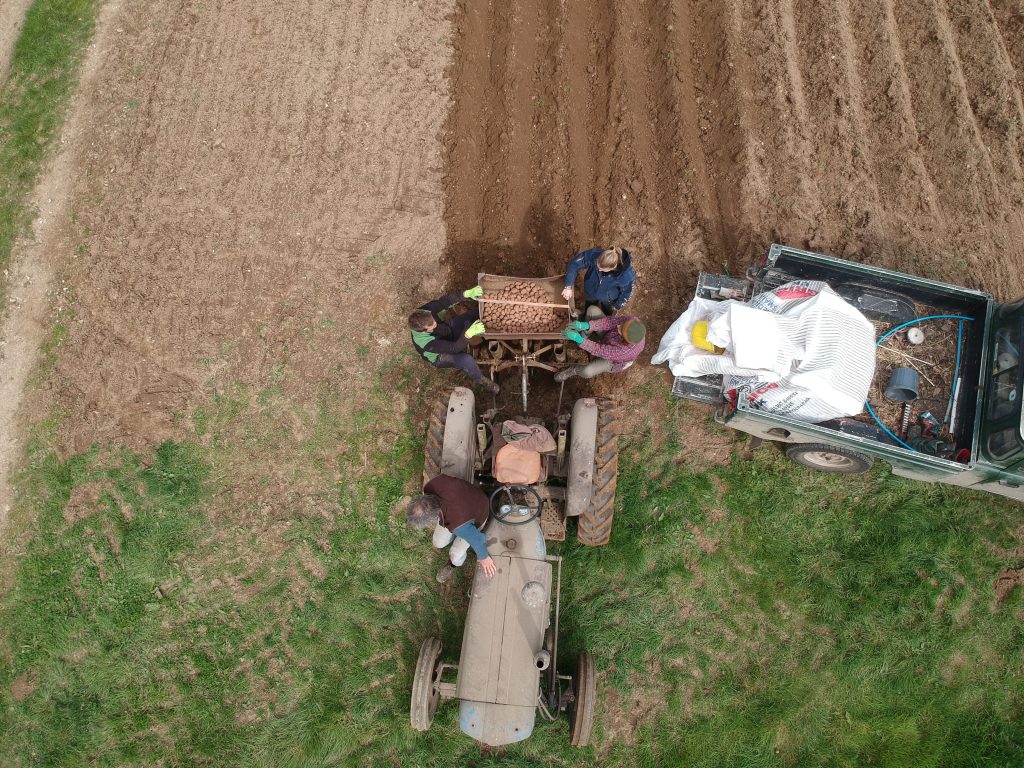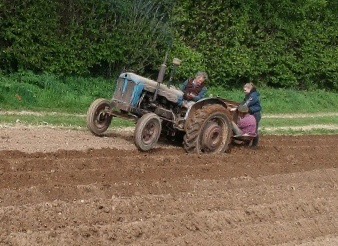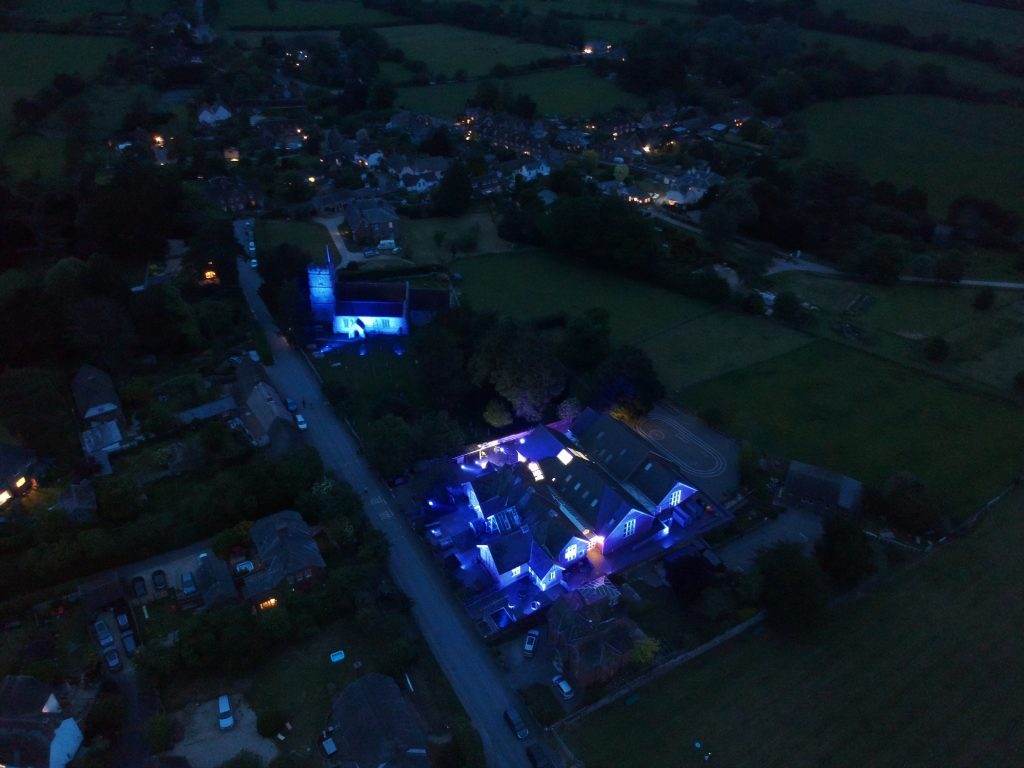View from the Hill 14th June 2020

Here is a sunset shot from beside the River Stour in Durweston, with hay on the ground, always risky so early in the season, but it made beautifully, 90 bales now smell delicious in the shed. Where the rest of next year’s fodder is to come from is a scary question, the drought has bitten really hard right at the time when we expect maximum grass growth.
The beasts in view have been growing really well on the meadow grass, in spite of the dryness, most of our grass had turned brown prior to this weekend’s wonderful rain, but these fellows have still managed to average 2.8kg weight gain per day for the last 3 weeks, and are very nearly fit. How much grass must they eat every day to manage that?

Turning round to face the river we see a quite different view, eight swans a-swimming, and nowhere near Christmas. They have attracted the attention of our neighbour’s cattle enjoying an evening tipple at the river’s edge.
A clutch of 6 cygnets is pretty impressive, though a family has been spotted with 9 cygnets elsewhere on the Stour, and a friend tells me of a family where the cygnets were taken by a fox.
The river water looked really clear, after so long without rain to stir up the riverbed or wash dust and soil into the water upstream. Clean enough to swim in, for those tough enough to brave the chill water. In May we recorded just 1mm of rain, the lowest of any month since records began in 1985.

Throughout May the sheep have been lambing, a very disappointing season in terms of numbers, not many lambs were lost at birth, but many ewes were empty, and low birth numbers indicate less than ideal conditions at conception. Casting the mind back to December, the poor sheep were carrying out our experiment on the oilseed rape, grazing it to reduce flea beetle larva survival, and enduring that relentless winter rain. Far from ideal for good conception rates, which can be improved by ensuring the ewes are on a rising plain of nutrition, meaning they shed more eggs. The rams weren’t enjoying the ground conditions either, so perhaps we shouldn’t be too surprised at low conception rates. On the plus side, the grazed oilseed rape has caught up well, and now one could be fooled into thinking we might have a half reasonable crop. I will report back in August.
Here are 4 pictures of the trial field, showing the plots where one area was ungrazed, and the rest was grazed. The first was taken on April 3rd, as the ungrazed plot came into flower, the grazed areas are well behind.

The next was taken on May 1st, a lot has happened in April, a fine and sunny month, pretty dry except for a wet period at the end. The ungrazed is tailing off from flowering, but the grazed area is really going for it, lots of branching, and flowering strongly.

The third shows the ungrazed plot on 17th May, where all petals have fallen. The grazed plots are still going, lots of branching and thickening up.

The fourth was taken when all had completed flowering, on 5th June, and you can barely discern any difference from the air. I have no idea which will yield better, although we already know that the grazed area has provided food for sheep for several weeks, it has shown us how to save money on fungicide and weedkiller, and it has meant that fewer flea beetle larvae returned to the soil to hatch into hungry adults next season.


As mentioned last month, these two cheeky fellows arrived at the beginning of May, they have provided plenty of entertainment, they have escaped a couple of times, they are very noisy at grub time, and their appetite seems to increase daily. The wet weather this weekend has given them the opening they needed to start rooting up the grass in their paddock, it’s what pigs like to do. Previously the soil was too hard and dry. They are Oxford sandy and blacks, a relatively rare, but robust breed, very happy outdoors, and being very hairy are immune to sunburn, apart from their ears, which look a little more delicate. As they get bigger, the light-hearted chewing of clothes and footwear has had to end, their jaws are very strong and they love chewing things, I suspect that if you fell down and couldn’t get up they might just start at one end and not stop till you were all gone! By the time they are 22 weeks old they should be a good shape without being too fat.

At the beginning of May someone had the mad idea that we should plant half an acre of potatoes. Faced with supermarket shortages, and the widespread madness of early lockdown, it was felt that this was one thing we could do to help survive the storm. Not being the best farm for spuds, too many stones, we had to choose the site with care. Also no planter and no seed was a slight problem, however a determined member of the family managed to track down a vintage planter in Cranborne and half a ton of Maris Piper seed from Taunton. On May 4th, the planter was hitched to the only tractor on the farm to have an axle track width to match the planter, and the team set forth…….

For those who don’t know much about spuds, to get spuds you have to plant spuds. The planter creates a ridge around the seed as it is deposited down a spout into the ground by a pair of willing operatives sitting on seats on the sides of the machine. On some old planters there is a wheel with a bell attached, which rings as it rotates and tells the planters when to drop a potato down the spout, to ensure correct spacing. In our case there was no bell, but the spacing turns out to be good, it was basically a case of dropping them as fast as you could.


Lacking modern conveniences such as Satnav, itec-pro controls, four wheel drive and air conditioning, the operators faced considerable challenges. As you can see it was a battle to keep the ridges straight, and even to keep all the wheels on the ground. When the planter finds some softer ground it likes to dig in, and a careful hand on the lift control is required to keep things on the level. Anyway all was successful on planting day, all we had to do now was to sit back and wait for rain. Or weeds more likely. Even though there was no rain, the tatties eventually emerged, as did a healthy collection of weeds. Having set out with the intention of an organic crop, our nerve nearly failed, until the decision was made, with rain forecast, to re-ridge the crop to bury the weeds. Fortunately most have been buried, and now the crop is growing so fast we hope it will smother and shade out further weed growth.

And here is how it went: (have you got sound on?)
Elsewhere on the farm, a bumble clings for dear life on to an oxeye daisy on a windy day:
Here is a honey bee checking out a poppy flower
For those not acquainted with Instagram, it is packed with pictures and short video clips, plenty from Dorset.

Our larger mob of cows and calves, along with old bull Postman Pat, have been enjoying the herbal ley in Wynchard field, in spite of the dryness the flowers and grass have kept on growing. The eight paddock rotation allows for a long rest for regrowth, and even a cut of early hay in the other herbal field near Folly. Once the cows move in they make a bit of a mess of the lovely flowers, of sainfoin (pictured), vetch, clover, plantain, lucerne, trefoil and more. This wide selection of herbs is supposed to give the cows more choice, and they will eat what they feel they need to stay healthy, a much broader diet than grass only. Although very pretty above ground level, I am more interested in what is going on below ground, in the rooting zone, where networks are developing between the plant roots and the mycorrhizal fungi surrounding them, which exchange soil minerals for sugary exudates from the roots, a synergistic relationship which creates biological activity in the soil, feeding the plants, and supporting a web of microbial activity in the soil. After 3 years of this, when we return the field to the arable rotation, we hope we will have increased organic matter in the soil which will support crop growth by an enhanced ability to hold nutrients and water. On top of this, the animals’ manure adds another source of nutrient to the mix, as does the vegetation that gets trampled into the soil by the animals. Graze a third, trample a third, and leave a third is what the old sages hold.

Organic matter is key to soil management; we were taught this in college decades ago, but seemed to forget it when lost in a youth-fuelled pursuit of high output using high levels of inputs, (mainly fertiliser and weedkillers).


Rocky demonstrating why the bottom of a tree canopy always looks flat.

Durweston School and church were lit up to celebrate the NHS one night in early May, it looked amazing.

What is going on here ?
For an interesting account of 10 years of Higher level environmental stewardship, have a look at this article:
Spot the odd one out:

And if you haven’t had enough of the slightly OTT multimedia edition this month, here is one more:

Hi George, I expect your modern combine will be able to tell you the difference in yield of the 2 plots of rape.
It will be interesting to know after harvest.
Jim
Keep them coming George!
As for your OSR regime, our bees loved the extended flowering period even from where we are. More honey in the hives than ever before.
Mike
Your articles get better and beterr, this was thoroughly enjoyable. Very soon you will interpret the farm as a natural historian. Then you will have reached Durweston’s zenith….Keep going
Just returned fro bill’s 70th 🐸🍺🛶🙈
Hello Georgious, what a delight. Looking forward to next installment on the pigs. Will they be for home consumption with a smoke house and a whole new adventure in cured porcine products?
I really love the idea of that herbal ley but have decided that I haven’t got time for all the cattle moving that they involve.
You should be investing in bees next.
Let us hope that the rain doesn’t keep going too much for the sake of your organic spuds – organic spray for potato blight is really nasty stuff in terms of heavy metal poisoning.
We recorded no rain at all in May, equally the lowest ever for us.
However a ‘dripping June sets all in tune’
The idea of dual use for crops reminds me of the original 4 course rotation where sheep grazed barley to encourage tillering, additional nutrients for the soil and a bonus yield from the land. There is so much we can learn!!
Hi George, did enjoy that … though was wondering if you were helping sow the spuds driving the old fergie or working the drone ….or both??
Up here in Scotland we were as dry as Dorset and getting worried as all the burns had dried up and fields burning up …. luckily alright now and managed to get a good crop of silage baled and wrapped. Hay we daren’t think about at the moment … weather very changable, our usual summer weather!
All best Ali
Very enjoyable and interesting George and we loved the photographs. Please keep it coming.
Brilliant as usual I do like the spud idea!
Hi George,
Clive sent me your last newsletter, a very interesting read.
Grateful if you could add me to your mailing list.
best
Robin